Texte paru dans: / Appeared in:
*

GRAMOPHONE (08/2014)
Pour s'abonner /
Subscription information
Ramée
RAM1303

Code-barres / Barcode : 4250128513036
(ID411)
Consultez toutes les évaluations recensées pour ce cd
~~~~ Reach all the evaluations located for this CD
Reviewer: David Vickers
Intrepid admirers of Baroque sacred music will probably know something about Handel’s so-called Brockes Passion (c1716), and there have also been high-profile recordings of settings by Telemann (Frankfurt, 1716) and Stölzel (Gotha, 1725). However, Barthold Heinrich Brockes’s innovative German Passion oratorio libretto Der für die Sünde der Welt gemarterte und sterbende Jesus was originally set to music by Reinhard Keiser for domestic performance at the poet’s house in Holy Week 1712. This recording is the fruit of collaboration between Belgian Baroque band Les Muffatti and Gramophone Award-winning vocal ensemble Vox Luminis; bass Lionel Meunier takes responsibility for his group of singers but the overall performance is conducted with ideal rhetorical solemnity and dramatic intensity by Peter Van Heyghen.
Peter Kooij is surprisingly bold in his delivery of some of Jesus’s vivid accompanied recitatives but there are plenty of moments that display his customarily compassionate singing, such as the soliloquy ‘Mein Vater, schau wie ich mich quäle’. Hugo Oliveira’s indignant condemnation of Caiaphas and his corrupt council is highly effective, and Fernando Guimarães sings Peter’s bitter selfreproach after his denial of Christ with the sort of potent yet dry timbre that reminded me of Peter Schreier. The Daughter of Zion has plenty to say in a host of short contemplative arias but Zsuzsi Tóth produces routinely lovely singing, whether in lively arias or gentler music that sways with melodious charm, such as ‘Heil der Welt, dein schmertzlich Leiden’, in which the magical effect of pizzicato strings and concertante flute and violin would not be out of place in one of Bach’s Weimar cantatas. Handel’s lessons learnt from Keiser at the Hamburg opera house are manifest in the richly pictorial woodwind in dialogue with Caroline Weynants’s rapturous singing in the Believing Soul’s ‘Dem Himmel gleicht sein buntgestriemter Rücken’, whereas the choral enquiries ‘Wohin?’ during ‘Eilt ihr angefochtnen Seelen’ were clearly a model for the comparable moment in Bach’s St John Passion a dozen years later.
Cliquez l'un ou l'autre
bouton pour découvrir bien d'autres critiques de CD
Click either button for many other reviews


